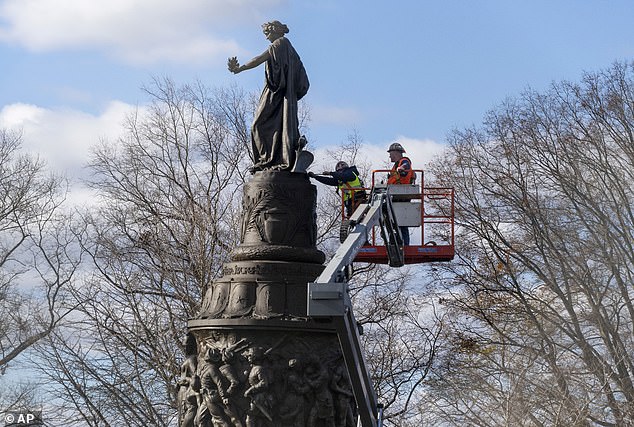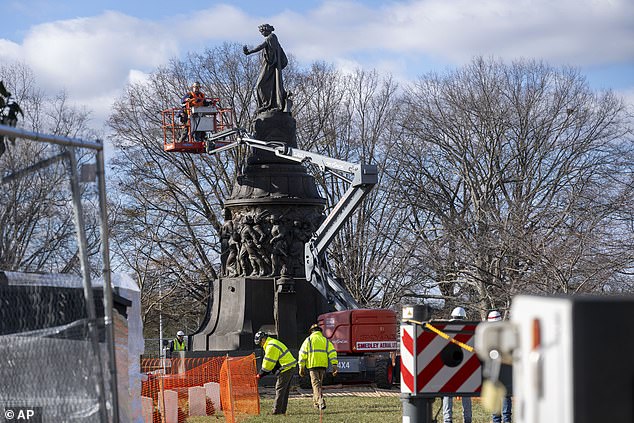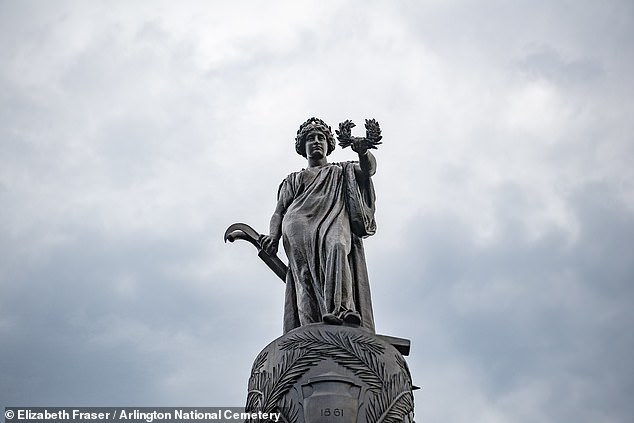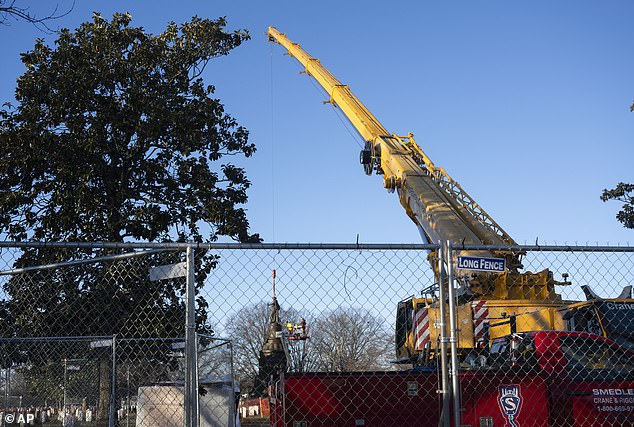Confederate monument in Arlington Cemetery has been REMOVED after judge lifted restraining order that prevented it from being removed
A federal judge has allowed Arlington National Cemetery to remove a century-old Confederate monument, just a day after blocking it over concerns that graves were being disturbed.
U.S. District Judge Rossie Alston issued a temporary injunction Monday after receiving an urgent call from the monument's supporters saying graves were being desecrated as contractors began work to remove the monument.
But he toured the site and saw that it was being treated respectfully and allowed the Confederate monument to be removed Tuesday.
“I have not seen any desecration of graves,” Judge Alston said during Tuesday's hearing. “The grass wasn't even disturbed.”
He issued an 18-page opinion lifting the order, saying allegations that the removal efforts amounted to serious desecration were “misinformed at best and inaccurate at worst.”
A federal judge has allowed Arlington National Cemetery to remove a century-old Confederate monument just a day after blocking it over concerns that graves were being disturbed

U.S. District Judge Rossie Alston issued a temporary injunction Monday after receiving an urgent call from the monument's supporters saying graves were being desecrated as contractors began work to remove the monument.

But he toured the site and saw it was treated respectfully and allowed the Confederate monument to be removed Tuesday
Officials began removing the structure Wednesday morning in front of a handful of onlookers, and a crane was used to lift the top of the Confederate monument.
Cemetery officials quickly tried to have the order rescinded. They said they are legally required to complete the move by the end of the year and that the contractors doing the work will have limited availability over the next week.
They issued a statement Tuesday saying they will “resume the deliberate process of immediately removing the Confederate Memorial from Arlington National Cemetery.”
'While the work is being carried out, surrounding graves, headstones and the landscape will be carefully protected.'
Erected in 1914, the Confederate Memorial is the latest of dozens of statues seen by many as monuments to racism.
They have been singled out for demolition by state and local leaders across the US since a nationwide public outcry in 2020 over the killing of George Floyd.
Congress formally ordered the elimination of all names, symbols, and statues commemorating the Confederacy from the entire U.S. military by 2021, creating a commission to oversee the undertaking.
An independent commission last year recommended the removal of the monument in Arlington, along with an investigation into Army bases with Confederate names.
The statue, designed to represent the American South and unveiled in 1914, depicts a bronze woman, crowned with olive leaves, standing on a 35-foot pedestal.
The woman holds a laurel wreath, plowstick and pruning shears, and at her feet is a Biblical inscription: 'They have beaten their swords into plowshares and their spears into pruning hooks.'
Some of the figures also in the statue include a black woman depicted as “Mammy” holding a white officer's child, and an enslaved man following his owner to war.

Officials began removing the structure Wednesday morning in front of a handful of onlookers, and a crane was used to lift the top of the Confederate monument.

The statue, designed to represent the American South and unveiled in 1914, depicts a bronze woman, crowned with olive leaves, standing on a 35-foot pedestal.

An independent commission last year recommended the removal of the monument in Arlington, along with a review of Army bases with Confederate names
Defend Arlington, working with a group called Save Southern Heritage Florida, has filed multiple lawsuits to keep the monument in place.
The group claims that the monument was built to promote reconciliation between North and South and that removing the monument undermines that reconciliation.
Tuesday's hearing focused largely on legal issues, but Alston questioned the heritage group's lawyers about the idea that the monument promotes reconciliation.
He noted that the statue depicts, among other things, a “slave” running after his “mass” as he walks along the road. What's appeasement about that?' asked Alston, an African American who was appointed to the bench by then-President Donald Trump in 2019.
Alston also chided the heritage group for filing its lawsuit Sunday in Virginia, while failing to note that just a week earlier it had lost a very similar lawsuit over the statue in federal court in Washington.
The heritage groups' attorneys argued that the legal issues were so different that it was not absolutely necessary that Alston knew about their legal defeat in the District of Columbia.
Virginia Governor Glenn Youngkin, who disagrees with the decision to remove the monument, has made arrangements to move it to land owned by the Virginia Military Institute at the New Market Battlefield State Historical Park in the Shenandoah Valley.
